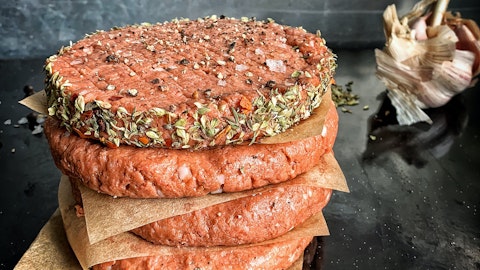In this article, we will be taking a look at the countries that produce the best quality leather in the world. To skip our detailed analysis, you can go directly to 5 Countries That Produce the Best Quality Leather in the World.
Leather Industry
Leather is consumed for various products such as high-end shoes, bags, and furniture, among others. Also, leather is considered to be a key component of the fashion industry. The quality of leather defines the price of a particular leather product. Fashion brands use high-end leather produced from cows, sheep, and crocodiles. For instance, crocodile leather bags are quite expensive as croc leather is rare and of high quality. The demand for luxury goods has been a major driver for leather in recent years.
In February 2023, Fortune Business Insights published a report on the global leather goods market size. According to the report, the global leather goods market size is expected to grow from $468.49 billion in 2023 to $738.61 billion by 2030. That shows a compound annual growth rate of 6.7% from 2023 to 2030.
The majority of the leather industry’s share is driven by shoemakers due to leather’s high prevalence of durable shoes for consumers. For instance, in 2022 Nike Inc. (NYSE:NKE) launched new shoes in its Air category announcing the Air Force 1 Low ‘07’ Fresh, Air Trainer ‘Midnight Navy,’ and Air Max 97 Coconut and Black. Nike Inc. (NYSE:NKE) uses upper and premium leather in the new Air shoes category. The footwear industry is one of the key drivers that create high demand for leather.
Meat Industry’s Contribution to Leather Industry
The leather industry has been a primary player in the global commerce market for millennia. Today, leather is one of the largest markets in the world with its products being used in shoes, fashion accessories, luggage, and automotive industries – to name a few. The production of leather involves the tanning and dyeing of the animal hides. Leather is the by-product of the meat industry as a large portion of leather is generated from cows, camels, pigs, goats, and sheep, among others.
According to Leather Naturally, 99% of the leathers are produced from livestock as a by-product. The core business of livestock is not for hides and skins but for meat and dairy products.
However, many activist organizations claim that animals are slaughtered brutally for their hides and skins to produce leather. According to PETA, leather is no friend of the environment as it causes pollution by the use of toxins in tanning. In addition, the meat industry is also responsible for environmental destruction as it contributes to the leather industry. As per PETA:
“With every pair of leather shoes that you buy, you sentence an animal to a lifetime of suffering. Instead, you can choose from hundreds of styles of non-leather shoes, clothing, belts, bags, and wallets.”
Sustainability in Leather Industry
The leather industry is working on sustainable ways of producing leather through plants and using non-toxic tanning agents. Multiple other factors are key to the sustainability of the leather industry such as waste management, reducing water consumption, and recycling leather products. As we mentioned, footwear holds a major share in the leather industry.
Nike Inc. (NYSE:NKE), one of the largest shoemakers in the world, wants to reduce its greenhouse gas emissions by 90% by 2050. Nike Inc.’s (NYSE:NKE) leather consumption is one of the major contributors to carbon emissions. To achieve its greenhouse gas emissions target by 2050, Nike Inc. (NYSE:NKE) is using synthetic leather and the company’s non-leather substitute for leather, Flyleather. Still, there are some of Nike’s classics that are high in demand and use animal leather such as Dunks, Air Force 1, and Air Jordan 1.
On March 23, Nike Inc. (NYSE:NKE) released its Fiscal Year 2022 Impact Report. In the report, Nike Inc. (NYSE:NKE) addressed its goals to meet consumer demand through the use of low-impact leather materials while reaching its 2025 target. In the Fiscal Year 2022 Impact Report, Nike Inc. (NYSE:NKE) mentioned:
“Our plan for 2025 is to decarbonize our portfolio of leather materials by shifting our sourcing toward those materials that are measurably lower impact (for carbon emission and waste) than average. In FY22, we have partnered with key suppliers to measure their impacts across the full value chain, from farm to factory, to inform our sourcing and identify opportunities for additional impact reduction across the supply chain.
We are also maintaining our standards, and require 100% of our leather suppliers to be members in good standing with Leather Working Group.”
Fashion brands that mainly rely on animal leather are also seeking sustainable ways to manufacture their leather products. LVMH Moet Hennessy Louis Vuitton SE (EPA:MC) is also working on producing sustainable leather products. On September 1, LVMH Moet Hennessy Louis Vuitton SE (EPA:MC) revealed that its partner Stella McCartney debuted new editions of its Falabella and Frayme bags during the ongoing Paris Fashion Week. The bags are made from a plant-based leather called MIRUM. In addition, LVMH Moet Hennessy Louis Vuitton SE (EPA:MC) operates a sustainable resale platform for fashion and leather goods known as Nona Source.
Despite companies’ development in sustainable leather products, most of their leather goods are produced from animal leather hides, which use chemicals for tanning. Therefore, companies such as Hermes International SCA (EPA:RMS) and LVMH Moet Hennessy Louis Vuitton SE (EPA:MC) are powering the demand for animal hides and skins.
Both Hermes International SCA (EPA:RMS) and LVMH Moet Hennessy Louis Vuitton SE (EPA:MC) are famous for their leather luggage items and bags. Hermes International SCA’s (EPA:RMS) famous tote bag Birkin is a trademark among leather handbags. Hermes International SCA (EPA:RMS) being one of the oldest leather goods manufacturers continues to roll on with its new stores.
On July 28, Hermes International SCA (EPA:RMS) in its half-year information report announced that it will be opening four new leather goods productions in the next four years. During H1 2023, Hermes International SCA (EPA:RMS) posted a total revenue of EUR 6.69 billion, increasing by 22.3% year over year. Out of the total revenue, leather goods and saddlery accounted for EUR 2.78 billion during H1 2023.
With increasing fashion trends and demand for leather from different industries, the production of leather goods will continue to remain strong. Let’s now take a look at the countries that produce the best leather in the world.

Our Methodology
To compile the list of 10 countries that produce the best quality leather in the world, we have gathered data on leather (hides and skins) exports of each country from the World Bank’s database of World Trade Integrated Solution. Our hypothesis is: the countries that are exporting more leather are expected to have better chances of producing the best quality leather.
We shortlisted the top 10 countries that had the highest exports of hides and skins in 2019, 2020, and 2021. The World Bank’s database had the latest data available until 2021. We took the average of the total exports of hides and skins of each country over the three years and ranked the ones that had the highest average exports. The list is ranked in ascending order of this metric. Here is the list of the 10 countries that produce the best quality leather in the world:
10 Countries That Produce the Best Quality Leather in the World
10. France
Average Exports for Hides and Skins: $4.57 Billion
France has a huge leather consumption as it is considered the hub of the fashion world, with most of the fashion companies based in the country. In 2021, France exported hides and skins worth $4.9 billion. France ranks 10th on our list of the countries that produce the best quality leather in the world.
French fashion designer LVMH Moet Hennessy Louis Vuitton SE (EPA:MC) is one of the leading leather manufacturing companies in the world. Hermes International SCA (EPA:RMS) and Nike Inc. (NYSE:NKE) are also among the top manufacturers of leather products.
9. United Kingdom
Average Exports for Hides and Skins: $4.70 Billion
The United Kingdom is famous for leather footwear and it has a huge marketplace. In 2021, the United Kingdom’s exports of hides and skins were $4.8 billion and it makes it to our list of the countries that produce the best quality leather in the world.
8. Germany
Average Exports for Hides and Skins: $5.27 Billion
Germany is home to some of the leading automotive companies in the world. The leather consumption from the automotive industry in Germany remains high. Germany exported hides and skins worth $5.6 billion in 2021. Germany ranks among the countries that produce the best quality leather in the world.
7. Italy
Average Exports for Hides and Skins: $5.47 Billion
Italy is another country that is known for fashion products. Italy exported $5.8 billion worth of hides and skins in 2021. Ranked seventh on our list, Italy is among the countries that produce the best quality leather in the world.
6. South Korea
Average Exports for Hides and Skins: $5.57 Billion
South Korea is one of the leading producers and exporters of hides and skins. In 2021, South Korea exported $6.4 billion worth of hides and skins. South Korea makes it to our list of the countries that produce the best quality leather in the world.
Some of the leading leather goods producers in the world include French fashion designer LVMH Moet Hennessy Louis Vuitton SE (EPA:MC), Hermes International SCA (EPA:RMS), and Nike Inc. (NYSE:NKE).
Click to continue reading and see 5 Countries that Produce the Best Quality Leather in the World.
Suggested articles:
- 12 Cheapest and Best Countries for Plastic Surgery
- 20 Biggest Supermarket Chains In The US
- Jim Cramer Recommended These 10 Stocks
Disclosure: None. 10 Countries that Produce the Best Quality Leather in the World is originally published on Insider Monkey.





